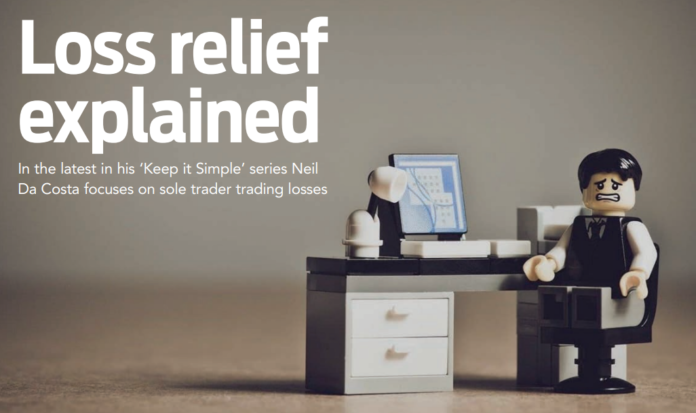April 2022
In the latest in his ‘Keep it Simple’ series Neil Da Costa focuses on sole trader trading losses.
In this month’s ‘Keep it Simple’ article I am going to show you how to deal with an exam favourite – income tax trading losses. In the current challenging environment, many small businesses have trading losses. By claiming loss relief, it is possible to generate substantial tax savings to help the business continue trading.
Continuing sole traders
Sole traders can offset the trading loss against the total income of either the current tax year or the previous tax year. The claim is an all or nothing claim and cannot be restricted to preserve the personal allowance.
The remaining loss after total income can be offset against the capital gains of the same tax year in which the loss claim is made.
Alternatively, the sole trader can choose to carry the loss forward against future trading profits of the same trade.
Simple example: Dexter’s Garage
Dexter is self-employed and made trading profits of £70,000 in the previous year but now has a trading loss of £20,000. In the following year, Dexter expects to make a small trading profit of £10,000.
Dexter also has rental profits to cover his personal allowance each year.
What are Dexter’s different options for using the loss and what do you recommend he does?
Solution to Dexter’s Garage
The first option is to claim loss relief against the total income in the current tax year which will involve offsetting the loss against the rental income.
The disadvantage is the loss of the personal allowance.
The second option is to claim loss relief against the total income in the previous tax year which will involve offsetting the loss against the trading profits of £70,000. The advantage is this will result in immediate tax relief and will save income tax at 40% (tax refund is 40% x £20,000 = £8,000).
The third option is to carry the loss forward against future trading profits of the same trade.
The tax relief available here would be restricted to the profits of £10,000 and would save income tax at 20% (tax relief is 20% x £10,000 = £2,000).
The disadvantage is that tax relief would be given in the future.
I recommend that Dexter claims loss relief against the income in the previous tax year to get an immediate tax savings of 40%.
New sole traders
In the first four tax years, opening year relief is available and the sole trader can carry the loss back against the total income of the three previous tax years on a first in first out (FIFO) basis.
Simple example: Farida’s Fashions
Farida was employed as a fashion designer earning £60,000 a year. She also has investment income to cover her personal allowance. She set up her own business but made a trading loss of £20,000 in the first year.
What loss relief can be claimed to give Farida loss relief as soon as possible?
Solution to Farida’s Fashions
Farida can claim opening year relief and carry back the loss three years to the earliest year first to get back some income tax she paid on her employment income.
She was earning £60,000 a year as an employee so was a higher rate taxpayer.
This will generate an immediate tax refund of 40% x £20,000 = £8,000. This tax refund will assist Farida’s cash flow in her new business.
Trading losses in closing years
When a sole trader ceases to trade, terminal loss relief can be claimed. The loss of the final 12 months can be carried back against available trading profits of the three previous tax years on a last in first out (LIFO) basis.
The loss consists of three elements: loss from the 6 April to the date of cessation, loss for the reminder of the 12 months preceding cessation and finally the overlap profits. If any of the first two elements result in a net profit, then the loss for that element is nil.
Simple example: Chaka’s Computers
Chaka has always made trading profits of £50,000.
For the final six-month period 6 April 2024 to 31 October 2024, Chaka made a trading loss of £100,000 and ceased trading. Chaka has £20,000 overlap profits brought forward.
Compute Chaka’s terminal loss relief and explain how he can use up the loss.
Solution to Chaka’s Computers
The terminal loss has three elements:
1. Loss from 6 April 2024 to 31 October 2024 £100,000.
2. Balance of the loss for the remainder of the 12 months preceding cessation.
This would be £50,000 profits x 6/12 = £25,000 profits so the loss for the second element is nil.
3. Overlap profits of £20,000.
This means that the total terminal loss available is £120,000. The loss can be carried back against the trading profits of the three previous tax years of £150,000 on a last in first out basis to generate an income tax refund.
• Neil Da Costa is a Senior Tax Lecturer with Kaplan in London. He is the author of Tax Condensed and Advanced Tax Condensed which summarises the entire syllabus using memory joggers




